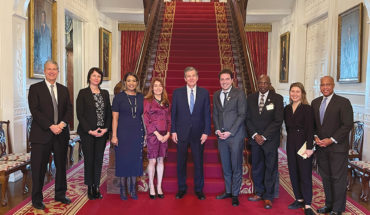by Liza Roberts
photographs by Missy McLamb
Seven years ago, Raleigh native Kelly Shatat was a pharmacist making necklaces for fun at her dining room table. Today she is the chief executive of Moon & Lola, her own multi-million-dollar company, selling jewelry in 10 countries and 46 states.
Thousands of pieces of fashionable, affordable jewels – like the signature gold monogrammed pendant she’s wearing today – make their way from Shatat’s bustling workshop in Apex to points around the globe each week.
Their colorful, preppy, feminine style is on-trend and recognizable, inspiring cultish love in female fans that range (truly) from 12 to 80. Go to any middle school in the Triangle, and you’ll see her pendants around tween necks; ditto their big sisters and moms in the carpool line. Sixty-something celebrity chef Paula Deen, 30-something actress Zoe Saldana, 20-year-old actress AnnaSophia Robb: They all wear the jewelry, which sells for $40 to $300 and comes in all kinds of shapes and styles, like swirly monograms, state-shaped charms, sparkly bows, quatrefoils, and signs of the zodiac.
They buy them at one of 1,000 stores nationwide, or online, or at Neiman Marcus, Nordstrom, or the Home Shopping Network website. New York and California are among the company’s biggest markets. The stand-alone Moon & Lola flagship store on Wilmington St. is part of Raleigh’s hip downtown nexus, a magnet on First Fridays; Shatat has just opened another store of her own on King St. in Charleston. Here in Apex, the 40-something entrepreneur also sells her jewelry from a corner of the brick-walled, lofty space where she runs the business. It’s also where her fleet of employees take in all the orders, assemble the jewelry, and send it all out.
The place is all shiny white lacquer furniture and bright pink accents. It hums with female energy. The unofficial employee uniform is clearly high heels, bright colors, and dangling earrings; the default attitude is gung-ho. “They drank the pink lemonade,” Shatat jokes.
These 34 women (and one man) are full of energy because they’re at the center of something electric; they’re also enthusiastically devoted to their boss, whom they describe as generous and inspiring. They know just how hard she’s worked and how much of herself she’s put on the line in the process: Shatat has funded Moon & Lola and its explosive growth entirely on her own, without debt. Her pharmacist’s salary paid for materials until she decided to do jewelry full time (not until 2010); for a while she even paid friends with jewelry for their help so she could keep up with demand. She has never taken on outside investors.
“I don’t know when the girl sleeps,” says Charlotte Harris, owner of Raleigh’s popular Charlotte’s gift shops, where Moon & Lola is the top seller. She was one of Shatat’s first retailers and describes her as savvy and forward-looking. Harris cites Shatat’s decision to hire an in-house graphic designer for her web site early on as a smart move; so, too, her devotion to quality, to classic design, and to customer service. “She’s a very intelligent person,” Harris says, “and this is a critical part of it: She is a very kind person. She really cares about other people. She’s never been after making the most money possible. She wants to make people happy.”
Because almost 85 percent of Moon & Lola’s jewelry is personalized with a monogram or name, Shatat says she has a special opportunity to do just that. Her customers often become attached to their pieces, tweeting photos of themselves with their new jewelry (see Paula Deen), and sending Shatat effusive thanks. “It’s really exciting to please people,” she says. “To know that you made them so happy.”
Running a finger over the gold-rubbed, swirling monogram on a ring in the workshop, she considers the popularity of these custom pieces. When she introduced them a few years ago, acrylic was a new idea. She’d been making metal monogrammed jewelry for a while when she saw some cut acrylic pendants in colors and funky shapes, like green deer antlers. Why not make monogrammed pieces the same way?
She found a man who cut acrylic for boats and convinced him to make monograms for her. Her first ones were black, because retailers had been asking for black jewelry. Soon black seemed limited. “Once we introduced color, it blew up…It attracted people like candy.”
Overnight, her mainstay monograms were not only rainbow-cheerful – she offers 30 shades – they were less than half the price of the silver and gold-filled versions. A trend was born, one that has attracted knock-offs. Shatat is not concerned: “We are the original acrylic monogram,” she says. “It’s why we’re in Nordstrom and Neiman Marcus. It just means we need to keep upping our game… The goal is to constantly be growing. And I think I have the same goal as a person. You need to be getting better every day.”
Early success
To Shatat’s way of thinking, using unusual materials like acrylic to make jewelry is business as usual. One of her early successes – earrings made out of embroidered fabric Indian patches – is still one of her favorites. But it was her very first piece back in 2004, another original combination, that got the ball rolling: pearls with ribbon.
At that point, making jewelry was just a creative outlet, a hobby she indulged in after long days as a pharmacist.
That’s when her best friend Avis Wicher, an interior decorator in Greenville, asked her to bring some jewelry to a Junior League gift show, to help fill her booth. Shatat made a pile of pearl necklaces that tied in the back with lengths of interchangeable ribbon. She decided she needed a name, a logo, and a tag for the necklaces. “I don’t do things half-way.” Inspired by the lighthearted nicknames she and Wicher gave each other back in their undergraduate days at Georgia’s Emmanuel College –Shatat was “Lola”; Wicher was “Moon” – Shatat had no trouble coming up with a brand for these jewels she’d made on a whim. Moon & Lola was born, even if Shatat didn’t know yet just what that meant.
“You cannot imagine the people who came flocking to her pearls and ribbon, the stores who snatched her up, the crowds she had,” Wicher recalls. Shatat ended up selling more than anyone else at the entire Junior League show. She left with orders for more from three retail stores – and with her head spinning. “And then it kind of snowballed from there.”
She credits her time as a pharmacist for honing her attention to detail, which she’s convinced is what made her jewelry stand out from the beginning. With those early pearl necklaces, she spent hours sealing the edges of each length of ribbon with a lighter so they wouldn’t eventually fray. (“You can’t imagine how many ribbons we burned,” says Wicher, who helped her.) Today, Shatat makes two of each ordered acrylic nameplate pendant – floating, thin bits of script – because they can break when assembled into a necklace, and she doesn’t want the order delayed.
She still approves every custom design because she doesn’t want things “going out into the world that don’t have the Moon & Lola aesthetic,” she says, for instance, anything “gothic.” She won’t do bad words, or “anything that seems derogatory.”
It’s more than good taste, it’s branding. “Branding is huge to me,” she says. “It was never my dream to be a jewelry designer, it was my dream to have a brand.” She describes hers as “clean lines, with a touch of girliness,” she says. “A modern twist on traditional.” It’s a reflection of Shatat herself, she says. “I want us always to be fresh and clean and new and appealing.” Wicher, or “Moon,” says the brand simply stands for “happy.”
And it is broader than jewelry. Moon & Lola has a growing beauty line, accessories like sunglasses and beaded handbags and has dipped into and out of clothing. Shatat says she’d like to launch stationery and “bring back” milk glass. “I want to be a lifestyle brand,” she says. “I tell people: Don’t put us in a box. We won’t stay there.”
Making it happen
So how do 35 young women in an Apex loft churn out 500-plus pieces of jewelry a day? They make it look easy. All orders come in through the web site on one end of the room, where the graphic designer and account managers also sit. Orders are brought over to the other side of the room, where assemblers gather the elements they need from a massive set of cubbies. At a long table in the middle of the room, they take these pieces – a chain, some jump rings, a monogram, and a clasp, for instance – put them together, and send it over to another desk, where it gets sent out.
Each of the monograms and other acrylic pieces is laser cut from 12- by 24-foot sheets in a workshop nearby, while other elements, like filigree discs, cotton “pearls” and various charms, are made all over. Each order gets its own “baby sitter,” ensuring it gets out accurately – with so many pieces personalized, this can be tricky – and on time.
“Customer service is key,” Shatat says. “I built the business on customer service. It all comes down to the golden rule. It always pays off.”
She says this, even though others haven’t always treated her the same way. In fact, it was a major setback that galvanized her decision in 2010 to finally put pharmacology behind her to work full time on Moon & Lola. When a major customer declared bankruptcy, effectively bilking her out of $32,000, “in that moment I made a decision,” she says. “I have a highly competitive nature. They could have put me out of business.” She realized just how much she cared. “I decided I wanted it to be all it could be, or I wanted to stop playing.” She started putting everything into it: Traveling to market, making contacts. Calling every shop that carried the Elizabeth McKay clothing line, since most of her retailers seemed to carry that line. Hiring a Los Angeles publicist to get her jewels on the necks of starlets and into the fashion spreads of glossy magazines like Lucky, InStyle, and O Magazine.
It was right about then that the acrylic pieces started to fly off the shelves, and Neiman Marcus, Nordstrom, and the Home Shopping Network came calling. Moon & Lola is 20 times bigger today than it was when she lost all of that money. “It changed everything,” she says.
Her husband of 14 years, an engineer currently working in the Middle East, is “amazed” by her success, she says. “I think he thought I had a hobby.”
A quote from Anais Nin is painted on a canvas in her office: “And the day came when the risk to remain tight in a bud was greater than the risk it took to bloom.” She came upon it in 2010, right when she was licking her wounds and considering her options. “It’s not my goal to be comfortable,” she says today. “When I feel afraid, I remind myself of that.”
As with many driven people, there’s something deeper motivating her. When her grandmother died recently, Shatat was going through old family papers to prepare a eulogy and learned for the first time that her grandmother and great-aunt had been promising singers as young women – so promising that a Nashville promoter had tried to take them on the road. Their father wouldn’t let them go, and they never did become professional singers. Shatat says that her mother, too, had a creative opportunity of her own thwarted when she won an art contest as a student and was offered a university scholarship that family circumstances prevented her from accepting.
Shatat says it made her reflect: “Why am I so blessed?” She decided her opportunities are gifts, and she is fortunate to have them, and to be challenged by them. “I feel like I’m living out three generations of what was supposed to happen. I’m living all of our dream.”







